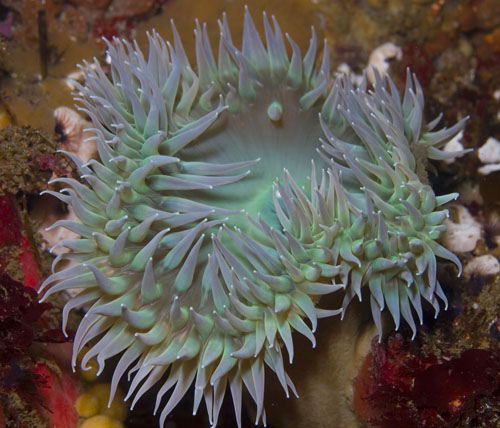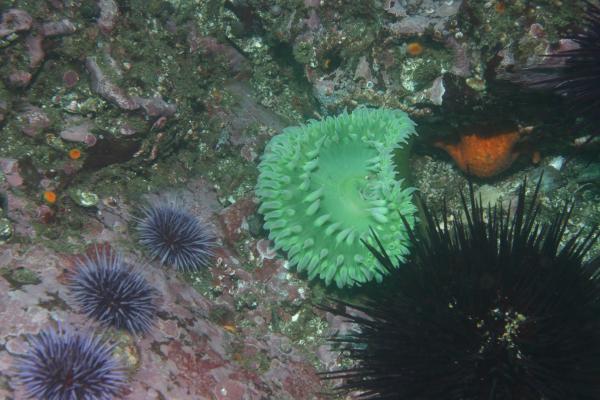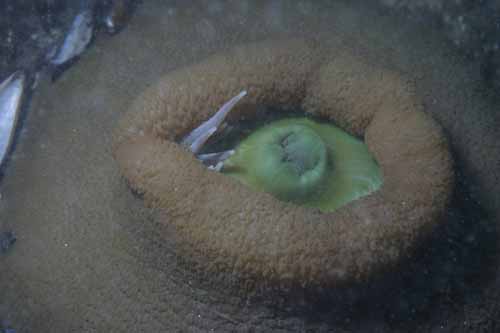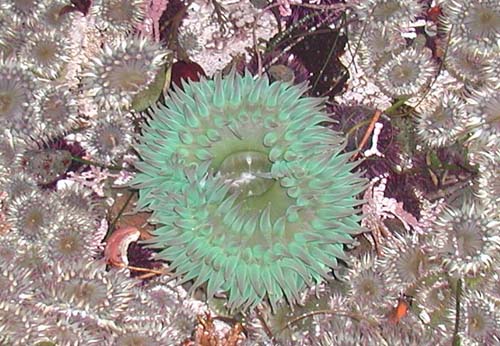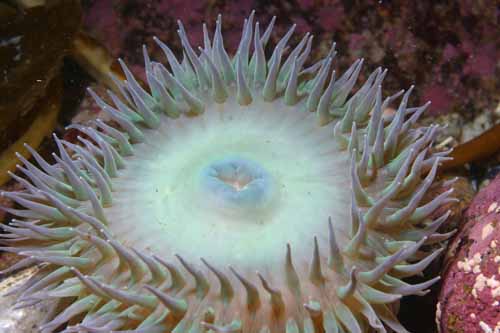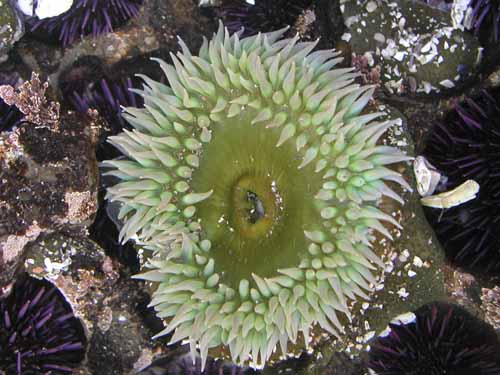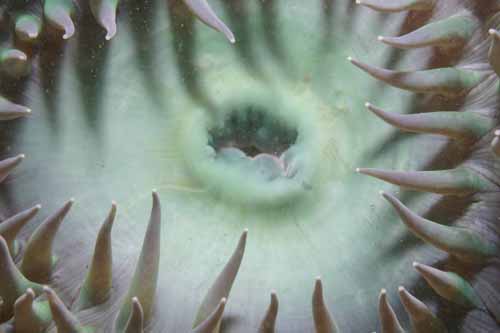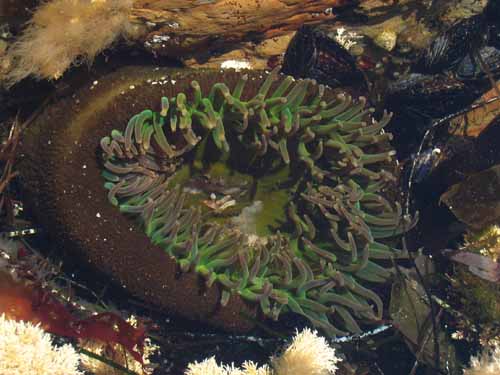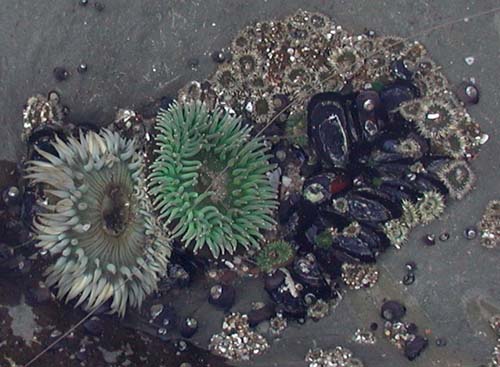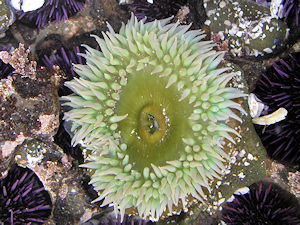
Giant green anemone
Anthopleura xanthogrammica
Overview
Key Features:
As its name indicates, the Giant green anemone is the largest green anemone in the world. Its column can reach lengths of up to 30 cm, and its crown can reach a diameter of 25 cm.
Similar Species:
Sunburst anemone (Anthopleura sola)Moonglow anemone (Anthopleura artemisia)
Aggregating anemone (Anthopleura elegantissima)
Primary Common Name:
Giant green anemoneSynonymous name(s):
Cribrina xanthogrammicaGeneral Grouping:
Corals and anemonesGeographic Range:
Unalaska to Panama
The Giant green anemone inhabits the low to mid intertidal zones of the Pacific Ocean, ranging continuously from Unalaska to Point Conception. It also occurs in areas of cold upwelling, possibly as far south as Panama.
Intertidal Height:
-2 to 2 feet (-0.6006006 to 0.60060060 meters)Notes:
Low intertidal and tidepools.
Subtidal Depth Range:
Minimum Depth: 0 meters or 0 feetMaximum Depth: 0 meters or 50 feet
Notes:
Occurs subtidally to a depth of at least 15 m. More commonly seen in the shallow subtidal, particularly in rocky areas with high wave action.
Habitats:
bay (rocky shore), exposed rocky shore, kelp forest, protected rocky shoreNotes:
On exposed coastlines, bays and harbors, on seawalls, rocks, tidepools, and pilings; from above low tide line, to about 50 ft. (15 m) depth. Each Giant green anemone is solitary, but is often in tentacle-tip contact with others in favorable tidepools and conditions, and can be found in densities of up to 14 per m². Although their habitat can become crowded, they do not display aggressive behaviors, seen in their smaller relative, A. elegan-tissima. A. xanthogrammica is restricted to the lowest tide zones, where surf and currents continually provide a fresh supply of water, and cannot survive where there is industrial pollution, sewage, or sludgy water.
Abundance:
Relative Abundance:
A. xanthogrammica is very much at home here in the Monterey Bay, growing to a size exceeded by few other anemones in the world. The giant green anemone is the most frequently observed local marine species by the layman, as it occurs in great numbers within rocky intertidal zones.
Species Description:
General:
The Giant green anemone, Anthopleura xanthogrammica, is a cylindrical greenish-brown column with green, bluish, or white tentacles; oral disk green, bluish-green, or grayish colors. The scientific name, Anthopleura xanthogrammica means "yellow lined flower." The column is usually covered with scattered adhesive par-ticles. Numerous thick, short, tapered tentacles in about 6 rings around the flat adhesive oral disk. Very firmly adherent to rocks and pilings; when contracted, the animal forms a hemi-spherical mound.
Distinctive Features:
Stinging cells called cnidocytes are located within the green anemones tentacles. These cells help the anemone paralyze its prey, but can cause no harm to humans. Although it moves slowly through use of its basal disk, it will usually stay attached when the tides move in and out. To prevent from dessication, giant green anemones will retract their ten-tacles and close, during low tides.
Size:
Column diameter: up to 17 cm (6.7 inches) Height: up to 30 cm (11.8 inches) Tentacular crown diameter: up to 25 cm (9.8 inches)
Natural History:
General:
Specimens of A. xanthogrammica that live in direct sunlight are bright green, while specimens found in caves and sun sheltered areas are paler. The quantity of green pigment produced by the anemone, relates to the health and efficiency of the photosynthetic symbionts (unicellular green algae and dinoflagellates), which live in the anemones tissue in a mutually beneficial arrangement. The anemones bright green pigment is thought to screen the symbionts from excessively bright light to avoid damage and desiccation. In dim light, the symbionts require as much light as they can get, and the anemones allow this, by producing little or none of the green pigment. In its preference for optimal light levels, the giant green anemone is similar to the aggregating species of Anthopleura. Giant green anemones that are found in deep pools and channels can reach sizes exceeded by few other species. Some Antarctic anemones are larger, specimens which have been reported as over 30 cm in diameter, with stinging capacities comparable to the stinging nettle. Although our form sometimes reaches a diameter of 25 cm, a bare hand can be placed in contact with the tentacles, and feel no more than a slight tingle and disagreeable stickiness. The Giant green anemone has been used in several pharmacological and chemical studies. Its tissues are the source of a new vertebrate heart stimulant and of a pheromone mediating an alarm response in both A. xanthogrammica and A. elegantissima. Growth of an individual anemone is often slow, while life spans are quite long. It has been found that A. xanthogrammica can live to an age of more than 80 years.
Predator(s):
Predators include the nudibranch Aeolidia papillosa, and the snail Epitonium tinctum, both of which feed on the tentacles, and the snails Opalia chacei and O. funiculate, and the sea spider Pycnogonum sternsi, which feed on the column. Sea slugs eat anemones, in-cluding the stinging cells, but they don't get stung. The slugs use the anemones stingers for defense against predators, by moving them onto their own bodies. A. xantho-grammica can defend itself using stinging cells located in the tentacles. However, these have little affect against larger invertebrates as well as vertebrates.
Prey:
The diet of A. xanthogrammica consists mainly of mussels, sea urchins, small fish, and crabs that have become detached from the substratum.
Feeding Behavior:
Omnivore, Photosynthetic, Scavenger, Sessile suspension feederNotes:
The larvae of A. xanthogrammica preferentially settle in mussel beds, in an-ticipation of this future food source. Later, they migrate downward to take up their cha-racteristic position, in the pools and channels below the bed, where they wait for food to drop down from above. Prey are paralyzed and captured after coming into contact with the anemones stinging tentacles. Once the prey has been paralyzed, A. xanthogrammi-ca pulls these animals into its mouth, located in the center of its crown. When digestion is finished, it excretes the waste through the same opening. The epidermis and tissues lining the gut of A. xanthogrammica contain living photosynthetic algae zoochlorellae, and the dinoflagelates zooxanthellae. These symbiotic protists can produce organic nutrients through photosynthesis that may also contribute to the nu-tritional needs of the anemone. Mussels and snails are washed into anemones waiting tentacles, as the wave's crash against the shore. The anemone eats the animals, then spits out the clean shells. Empty snail shells, may become homes for hermit crabs. The hermit crab Pagarus samuelis often walks up and down the column of the anemone, even walking through and stroking the tentacles and probing the mouth opening, all without being stung. It is possible that the hermit crab becomes so coated with mucus from the anemone that the anemone responds as if the crab were its own tissue. Hermit crabs which are not pre-viously associated with the anemone may be eaten, or simply taken into the gastrovascular cavity and then later released.
Seasonal Behavior
May - August
Reproduction:
Giant green anemones release sperm and brownish eggs in late spring and summer, pro-ducing pelagic, planktotrophic larvae. Larval development has not been closely followed, but the larvae swim or float freely for some time, and become widely dispersed.Issues
Monterey Bay National Marine Sanctuary:
The giant green anemone will always be found in situations where it is reasonably sheltered from the full force of the surf. For this reason, and because it is quite likely to have been first seen in the tidepool regions, it has been treated as a member of the protected outer coast fauna. A. xanthogrammica cannot survive where there is industrial pollution, sewage, or sludge. Anthopleura xanthogrammica has been the source of several medical studies. Contained within its tissues is a cardiotonic agent that has been associated with favorable stimulatory effects when introduced to the vertebrate heart. Clinical studies show that this agent is a good candidate in the treatment of a failing heart, and has considerable advantages over currently used drugs.References
- Carlton, J.T. 2007.
The Light and Smith Manual, 4th edition
Intertidal Invertebrates from Central California to Oregon
University of California Press. 1001 p.
- Meinkoth, N.A. 1998. National Audubon Society Field Guide to North American Seashore Creatures. A.A. Knopf, New York, NY. 813 p.
- Morris, R.H., D.P Abbott, and E.C. Haderlie. 1980. Intertidal Invertebrates of California. Stanford University Press, Stanford, California. 690 p.
- Ricketts, E. F., J. Calvin, and J.W. Hedgpeth. 1985. Between Pacific tides. Stanford University Press, Stanford, CA. 652 p.
- Sparks J, 2006. Ocean: the world's last wilderness revealed. American Museum of Natural History. P. 63-65, 487
- WWW
Animal Diversity Web http://animaldiversity.ummz.umich.edu/site/accounts/information/Anthopleura_xanthogrammica.html
Accessed 8/19/09 for Giant green anemone
Accesed 3/31/09 for Pycnopodia helianthoides
Accessed 8/1/09 for purple sea urchin
Accessed 11/11/09 for American Avocet
Accessed 12/15/2009 for Black-crowned Night Heron
Accessed 07/07/2009 for Pied-billed Grebe
Related Information
Project Database
Photo Library
Click on an image below to view a larger version in the SIMoN Photo Library. You will also be able to view important information on each photo such as photographer, date, caption and more
